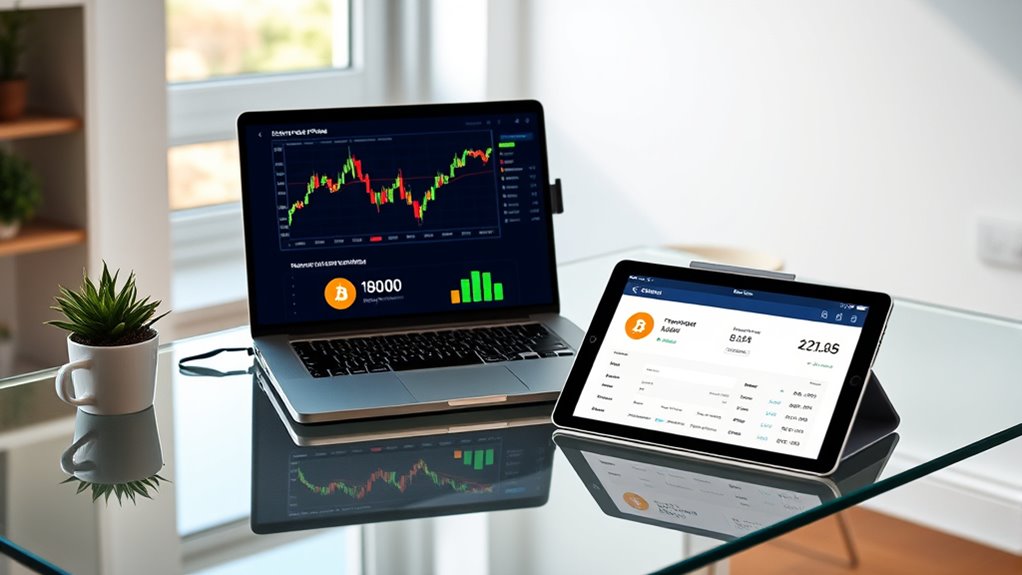To include Bitcoin in your 401(k), start by checking if your plan allows alternative assets or offers a self-directed option. You’ll want to explore funds or accounts that partner with digital asset custodians, ensuring proper security and compliance. Keep in mind the risks and limit your exposure to volatile assets. Staying updated on regulatory changes and best practices is key. If you continue, you’ll discover how to navigate the process smoothly and confidently.
Key Takeaways
- Check if your employer’s 401(k) plan allows alternative assets or offers Bitcoin investment options.
- Consider using a cryptocurrency fund or a self-directed brokerage option within your 401(k).
- Ensure proper custody and security measures through third-party platforms or specialized digital asset providers.
- Diversify your portfolio by setting limits on Bitcoin exposure and balancing with traditional investments.
- Stay informed about regulatory updates and monitor Bitcoin’s performance to manage risks effectively.
Understanding the Regulatory Landscape for Bitcoin in 401(k)s

How does the regulatory landscape shape the inclusion of Bitcoin in 401(k) plans? It heavily influences whether you can add Bitcoin to your retirement account. The U.S. Department of Labor oversees fiduciary duties under ERISA, emphasizing that plan sponsors must prioritize participant interests. This means they have to carefully evaluate the risks associated with cryptocurrency investments, especially given Bitcoin’s volatility. Recent regulatory changes have been cautious, with some guidance rescinded to explore broader access to alternative assets like crypto. Employers and plan providers need to ensure compliance, often limiting exposure to a small percentage of your portfolio. Additionally, the evolving regulatory environment can impact the future availability and security of including Bitcoin in retirement plans. As the legal environment evolves, it’s essential to stay informed, as new rules or guidance could relax or tighten restrictions on including Bitcoin in your 401(k).
Evaluating the Benefits of Adding Cryptocurrency to Retirement Plans

Adding cryptocurrency like Bitcoin to your retirement plan can offer notable benefits, especially regarding diversification and growth potential. By including Bitcoin, you reduce dependence on traditional assets, which can help protect your portfolio during market downturns. Bitcoin’s historical price increases suggest strong growth opportunities, potentially boosting your retirement savings. It also aligns with the trend of embracing alternative assets, giving you exposure to innovative investment options. Additionally, recent efforts to democratize access make it easier for individual investors to participate. Incorporating Bitcoin thoughtfully can enhance your long-term strategy, especially if you’re comfortable with some risk. Moreover, understanding the AI security landscape is essential as digital assets become more integrated into financial systems, highlighting the importance of secure investment practices. Overall, adding cryptocurrency can diversify your portfolio, increase growth prospects, and keep your retirement plan aligned with evolving market trends.
Recognizing the Challenges and Risks Associated With Bitcoin Investments

While the potential benefits of including Bitcoin in your retirement portfolio are compelling, it’s important to recognize the significant challenges and risks involved. Understanding these risks helps you make informed decisions.
Here are key concerns to contemplate:
- Volatility: Bitcoin’s price swings can be dramatic, risking substantial losses that may impact your retirement savings.
- Regulatory Uncertainty: Evolving rules and government scrutiny can affect the legality and accessibility of Bitcoin investments in your 401(k).
- Custodial and Valuation Difficulties: Managing and accurately valuing digital assets is complex, which can lead to errors or disputes over asset worth.
Being aware of these risks ensures you approach Bitcoin investments cautiously and with proper risk management strategies.
Exploring Investment Options and Vehicles for Cryptocurrency Inclusion

To include cryptocurrency like Bitcoin in your 401(k) plan, plan sponsors must consider the investment vehicles available to facilitate this asset class. One option is offering a dedicated cryptocurrency fund or fund-of-funds that invests in Bitcoin and other digital assets. These funds are managed by professional asset managers who handle custody, valuation, and compliance. Another approach involves creating a self-directed brokerage option, allowing participants to select alternative investments, including cryptocurrencies, through approved custodians. Some plans might also explore partnership with third-party platforms specializing in digital asset custody and trading, ensuring secure storage and transparency. Carefully selecting the right vehicle helps balance accessibility, security, and regulatory compliance, enabling participants to diversify their retirement portfolios with cryptocurrencies effectively. Incorporating diversification strategies can further help mitigate risks associated with digital assets.
Ensuring Fiduciary Compliance and Best Practices

Fiduciary compliance is the foundation for successfully integrating Bitcoin into 401(k) plans. To meet your responsibilities, you need to follow best practices that prioritize participants’ best interests.
First, thoroughly evaluate Bitcoin’s risks and guarantee it aligns with your plan’s overall investment strategy. Second, implement clear policies on the percentage of assets allocated to cryptocurrency, preventing overexposure. Third, seek external expertise or legal advice to stay compliant with ERISA and regulatory standards. Additionally, understanding the role of contrast ratio can help assess the potential impact of volatile assets on the overall portfolio performance.
Navigating Custodial and Valuation Complexities

Handling custodial and valuation issues is a critical step when incorporating Bitcoin into your 401(k) plan. Unlike traditional assets, Bitcoin requires specialized custodians equipped to securely store digital assets. You’ll need to choose custodians with digital wallet technology, like cold storage, to protect your investment against theft or hacking. Valuation also becomes complex because Bitcoin’s price fluctuates rapidly. You must ensure accurate, real-time pricing to reflect its true value in your plan. Visualize this with the following:
| Custodial Approach | Valuation Method |
|---|---|
| Cold Storage Wallets | Live Market Price |
| Third-party Digital Custodians | Frequent Price Feeds |
| Self-Custody (Advanced) | Continuous Monitoring |
Staying on top of these complexities helps you maintain transparency and compliance. Additionally, understanding the tax implications of including Bitcoin in your 401(k) can help you optimize your investment strategy.
Implementing Risk Management Strategies

Implementing risk management strategies is essential to safeguarding your participants’ retirement savings when including Bitcoin in your plan. To manage potential risks effectively, consider these approaches:
- Set investment caps: Limit Bitcoin’s percentage in participants’ portfolios to reduce exposure to volatility.
- Diversify assets: balance Bitcoin with traditional investments like stocks and bonds to minimize overall risk.
- Regular monitoring: continually review Bitcoin’s performance and adjust allocations as market conditions change.
- Incorporate volatility mitigation techniques to further protect against sudden price swings and ensure that Bitcoin remains a controlled part of the overall investment mix. These strategies help protect your plan from sudden price swings and ensure that Bitcoin remains a controlled part of the overall investment mix. By proactively managing risk, you can provide a more stable retirement outcome while offering participants exposure to innovative assets.
Keeping up With Industry Trends and Legal Developments

Staying informed about industry trends and legal developments is essential as the landscape for including Bitcoin in 401(k) plans continues to evolve. Regulatory bodies, like the Department of Labor, are paying close attention to how cryptocurrencies are integrated, emphasizing fiduciary responsibilities under ERISA. Recent executive orders have encouraged the inclusion of alternative assets, including digital currencies, to boost diversification. Meanwhile, industry players are developing new investment products tailored for retirement plans, signaling increased acceptance. Legal guidance is shifting, with some previous restrictions being rescinded to expand access to these assets. As a participant, keeping up with these changes helps you understand potential opportunities and risks. Monitoring asset regulation and market trends is crucial to make informed decisions aligned with evolving regulations and market trends.
Planning for the Future of Cryptocurrency in Retirement Portfolios

As the landscape for cryptocurrency in retirement portfolios continues to evolve, proactive planning becomes essential to navigate potential opportunities and risks. You need to stay ahead by considering how Bitcoin fits into your long-term strategy. Here are three key steps:
- Set clear limits: Decide what percentage of your portfolio you’re comfortable allocating to Bitcoin to manage risk.
- Stay informed: Keep up with regulatory changes and industry trends that could impact your investment options.
- Diversify wisely: Combine Bitcoin with traditional assets to balance growth potential and stability. Understanding the role of cryptocurrency in investment portfolios can help you make more informed decisions.
Frequently Asked Questions
Can I Directly Purchase Bitcoin Through My 401(K) Plan?
You generally can’t directly buy Bitcoin through your 401(k) plan. Most plans don’t offer direct access to cryptocurrencies yet due to regulatory and custodial challenges. Instead, some plans may include Bitcoin indirectly through specialized investment vehicles or funds. Check with your plan administrator to see if they offer any crypto-related options or consider alternative ways to diversify your retirement portfolio with digital assets.
What Are the Tax Implications of Investing in Bitcoin via a 401(K)?
When you invest in Bitcoin through your 401(k), you generally don’t face immediate tax consequences because your contributions are tax-deferred or tax-free, depending on your plan type. Any gains within the account grow tax-free until withdrawal, usually at retirement, when they’re taxed as ordinary income. Keep in mind, early withdrawals may incur penalties, and specific rules vary based on plan structure and regulations.
How Does Bitcoin’s Volatility Affect My Retirement Savings?
Bitcoin’s volatility can markedly impact your retirement savings by causing substantial value swings. When prices spike, your investment could grow quickly, but sharp drops might erode your savings unexpectedly. This unpredictable fluctuation increases risk, so you should consider limiting your exposure and diversifying your portfolio. Keep an eye on market trends and stay cautious, as sudden price shifts could affect your long-term financial security and retirement goals.
Are There Any Fees Associated With Including Bitcoin in My 401(K)?
Yes, there are fees involved when including Bitcoin in your 401(k). You might pay management fees for specialized investment vehicles or custodial fees for securely holding your digital assets. Additionally, transaction fees can apply when buying, selling, or transferring Bitcoin within your plan. These fees can vary depending on the plan provider or platform used, so it’s essential to review your plan’s fee structure carefully before investing.
Which Providers Offer Bitcoin Investment Options for 401(K) Plans?
You can look into providers like Fidelity Investments and others that are beginning to offer Bitcoin investment options for 401(k) plans. Fidelity has announced plans to add Bitcoin, responding to rising interest from plan sponsors. Keep in mind, not all providers currently include cryptocurrency options, so you’ll want to check with your plan administrator or employer to see which providers are offering these innovative investment choices.
Conclusion
Adding Bitcoin to your 401(k) is like sailing into uncharted waters—exciting but requires careful navigation. Stay informed about regulations, weigh the risks, and choose reputable investment options. By doing so, you’ll steer your retirement ship toward a future that embraces innovation without losing sight of security. Remember, with the right strategies, you can turn the unpredictable tides of cryptocurrency into a steady harbor for your financial dreams.









